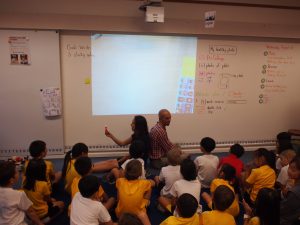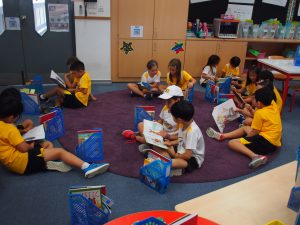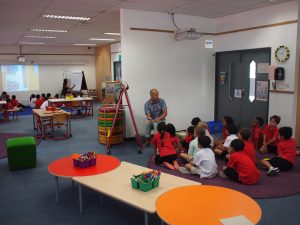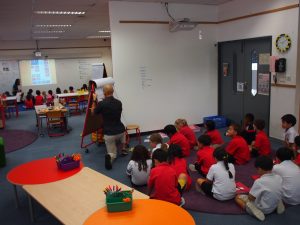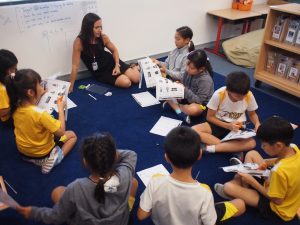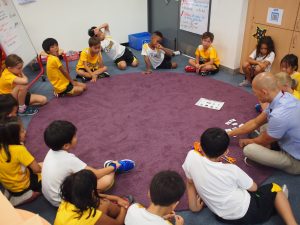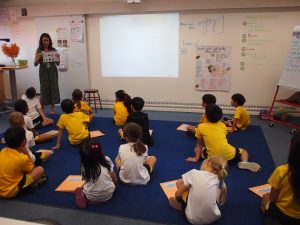Team Teaching and Co-Teaching for Differentiation and Collaboration
By Ed Hagen, to be published in ‘Globally Informed’ journal for International Educators
It’s the first day of school, and families anxiously check classlists to see which class they will be in. We wait at the door, just as excited as the second graders. As 42 smiling faces walk in, we see kids excitedly run in and try out the many different learning spaces. They say to their parents “This room is so cool!” Parents look around the room, some excited and some with a sense of puzzlement. We enthusiastically greet each family, and begin to answer their questions. “Why is this room so big? Which one of you is the real teacher? Just how many kids are there? How do you keep track of them all?” We also respond to comments like “This is so great! I hear schools in the US are doing this” or they look at their child and say “Are you so excited to be in this fancy classroom? You have so many friends here already!” Welcome to our team room! This is the first day of our year of team teaching.
How it Started
A few years ago, one of our dear colleagues (who has now moved on to another school) approached one of us, looking for someone to join her on a new adventure. One of us had team taught years before in the Philippines. When approached, she was so excited to have the opportunity to try team teaching again, this time in a new context. The two of them wrote a proposal, and were very pleased to hear that the principal also had experience with team teaching and was very much in favor of this model. They met with the learning spaces coordinator to choose furniture to suit flexible learning spaces. They then met with grounds staff to make plans to break down the wall, and to create spaces for writable walls. When parents first learned their children were in this new classroom, there was a mix of excitement and concern. One parent even asked “What if we don’t like one of you!” As the year went on, they saw excitement from parents and students, and by the end of the year, one of our toughest critics in the beginning, thanked us and said that, “it was such a wonderful experience for his child.”
What Does Team Teaching and Co-Teaching Mean for Our Class?
The elementary classroom is something we love for so many reasons and as lifetime elementary educators, we appreciate that teaching is a profession where we can constantly try new things and grow. This year we have combined team teaching and co-teaching with a group of 42 wonderful 2nd graders. Google team teaching or co-teaching and one will be overwhelmed with the definitions. For the purpose of this article, we will define each practice. Team teaching is when two or more teachers share responsibilities for a group of students. In our case, it’s two elementary teachers teaching a group of 42 students in one large space. Co-teaching is when a teacher with an area of expertise or specialty joins a homeroom class to support a specified group of learners. In our case, our co-teacher specializes in instructing students who are learning English as an additional language.
Creating a Team Learning Identity
We wanted our students to feel like they are part of a supportive community of learning and we worked together to establish a group identity right away. We live in Thailand, and this character, ๒, pronounced “song”, is the number two in Thai. We are two classrooms in grade two. Together with our students, we created a logo, handshake, dance, and a song. Our students wrote “habits of Team ๒,” where they outline habits of successful learners and friends. Our students sing about these positive attributes and habits in the “Team Song Song.” These things have enabled our learners to create and immerse themselves in a shared culture of emotional safety and positivity. We felt it was important to establish cohesiveness and unity for a larger group of learners.
A Typical Day in Team ๒
We use a variety of models to meet our learners’ needs. Our most common model is parallel teaching. During parallel teaching, two or three teachers are teaching the same (but maybe slightly differentiated) lessons simultaneously. The same teaching point is used with each group, but models, mentor texts, or guided practice may be different. Students are strategically grouped prior to the lesson. Our class has many students who are learning English as an additional language, so usually one of the groups may be formed to respond to this need in the given subject. This provides an opportunity to shelter language and language skills for this group. We also use the workshop model. The lesson is usually 8-10 minutes long and is followed by a time for students to independently practice the skills taught. During this time, teachers typically work with individual students (conferral) or instruct small groups. In addition to 2 teachers and 1 co-teacher, we have two assistant teachers who also confer and teach small groups. At the conclusion of the independent practice period, the instructional groups come back together to share, celebrate and bring closure to the lesson.
Flexible Space, Flexible Learning
Our classroom was specially designed for our model. To create the space, we asked that a wall be taken down between two regular sized classrooms, and in its place we have a half wall. The room is open, bright, and has a variety of furniture and resources to enable students to engage in learning comfortably and with choice. Our classroom has areas designed for instructing students. Each one of these spaces is different and utilizes a different set of resources to meet needs.
A core belief in our team teaching room, is that students have a variety of spaces in which to work comfortably. Students can stand at a table or counter, they can lie on the floor with a clipboard, they can sit in a private workspace or at a table with a larger group of students. We have kneeling tables available as well. As adults, we like to choose a working space that best suits us at any given time, and we believe in extending that choice to students. We often find that students with sensory needs benefit from finding spaces that best suit their needs. With the flexible seating, comes an opportunity for self-reflection and metacognition. Students are regularly encouraged to think carefully about choosing a space that helps them focus and do their best work. The room has many writable surfaces such as walls, tables, and furniture. Much of the furniture is on wheels, so it can be easily moved when needed. Students choose where they sit most of the time. One small, but important design idea, was naming each section of the class. We chose to give names from our host country, and this naming system helps with management and flow of students.
It’s All About Grouping!
Our model is based on strong mechanisms to form and manage groups in each content area. This is at the core of our collaboration together. The way students are grouped is based on the subject and content or skills we will teach them. We consistently switch between skill, ability, readiness, and interest groups. The main difference between a single teacher classroom is our grouping decisions happen collaboratively. We reflect and decide using our collective intelligence. In this way, we embody the idea of co-teaching. According to Santamaria’s & Thousand’s research, co-teaching is an effective way to meet the needs of a classroom’s diverse learners. These needs include English language learners, students with learning disabilities, and high-risk students (Santamaria, Thousand, 2004). Our parallel teaching and co-teaching model allows all of our students to benefit from co-teaching, not just one particular demographic.
Consistently changing the way students are grouped helps to avoid students being “tracked,” which means staying in the same group with similar ability peers for a long period of time. Within a subject, students sometimes excel in a particular skill set. Grouping and teaching them based on skills helps us better differentiate and individualize instruction. Ability grouping allows teachers to differentiate lessons, materials, and expectations so that learning is within learners’ zone of proximal development. Readiness grouping allows the instruction of new skills and concepts based on a collective body of knowledge about each student’s ability to acquire new skills/knowledge. Interest grouping allows students to choose what or how they want to learn. This allows students to take more ownership of their learning and mobilize themselves as greater stakeholders. Sometimes, we implement, “seminars.” This is when students choose the skills they want to be taught as a group.
Grouping decisions are managed with digital data walls. A digital data wall is simply a document with all of our students’ pictures arranged in groupings with labels. We have a detailed record of which group students were in and when. This informs future decision making and instructional next steps. We often vary which teacher teaches which group so that students may benefit from our varied backgrounds, areas of strength, and personal connections. One common struggle that teachers have it trying to meet the needs of all learners. By having a larger pool of students and teachers to work with, and by flexibly grouping, we can better work with students who don’t fall into the middle area of ability. Our students who need challenge, can work with other students with similar abilities. Our students who need support can work in a small group with more scaffolds in place, to help them access content and skills. Changes in grouping happen frequently. By doing this, we feel that no negative student stigmas or mindsets develop around learning because changes in groups and the size of groups happens frequently. A learner may not always be in a group they view as less advanced.
Embedded Collaboration
Our collaboration operates under the overarching idea of co-equal status. Our co-teacher and each partner teacher maintains equal statues collegially and instructionally. Bill and Ochan Powell (2016) discuss how it’s important to, “be sure teachers preparing to co-teach have open and explicit conversations about how they’ll work together—who’ll take responsibility for what throughout the teaching cycle, including planning, instruction, assessment of student learning, and reflection on process” (p. 64). We intentionally worked toward this in the early stages of our planning by addressing larger ideas such as the instructional model we wanted to use, and which contexts worked well for different grouping methods. This set the stage for future conversations and collaboration. Because our co-teacher is shared with other teachers in our grade level, we worked toward lifting her status. This is important because our co-teacher is only present during literacy instruction. “Co-teachers must plan the unit of study together. To lift the status of the “support” teacher, it’s important that the tasks assigned to each co-teacher be of equivalent value in the eyes of both teachers and students. Establishing co-equal status doesn’t happen by accident; it requires deliberate planning” (p. 64). Strong collegial relationships between partner teachers and co-teachers that lead to collaboration are at the heart of our model. Each of us maintains co-equal status and in doing this our roles as support teachers or primary teachers are often blurred in a positive way. Intervention and remediation can happen in a fluid way our students are comfortable with. We meet once every six days to plan and reflect on our instruction. This time is also used for discussing students of concern.
Our collaborative planning time allows us to implement proactive data-driven decision making. Our review of formal and informal data and observations allows us to be both timely and responsive to student needs. Brown, N.,Howeter, C., & Morgan (2013) support the notion of data driven dialogs within co-teaching models: “The co-teaching team should be able to collect student assessment data, track and analyze student progress, and make instructional decisions based on student data” (p. 89). This allows us to identify and support students with learning, language, and behavioral needs early on, and then take action in meeting their needs.
We design interventions to implement within our parallel instruction model, implement them collaboratively, and then reflect. This is something unique to team teaching that we value and feel that students benefit from. In our team teaching model, it’s embedded in our formal discussions as well as informal discussions we have at the conclusion of each lesson. Team teaching allows us to use a problem-solving model. Three of us work to design differentiated instruction based on students’ needs and strengths in order to close gaps. This approach helps us to meet the needs of ALL learners and gives us flexibility and creativity in how we problem-solve together, whether this is differentiation or a specific intervention for an individual or group. Strong communication is an essential part of our work together. Communication is essential to the success of any collaborative partnership, allowing for individuals to develop and foster relationships” (Brown, N., Howeter, C., & Morgan p. 85). Our consistent communication allows us to foster strong relationships. This leads to collaboration that benefits our learners.
Our varied backgrounds allow different perspectives and areas of expertise to benefit our learners. One of us has spent more time of our teaching career in grades 3-5, while the other has spent more time in grades 1-2. Our co-teacher has spent much of her career working as a specialist in the area of language acquisition. We teach and learn for one another and feel that our students benefit from this collaboration on a daily basis. We feel that our differences help us learn from each other. We value teaching through inquiry, and blend this with direct instruction; we all learn from this diversity. Although we learn through our diversity, some common beliefs and assumptions are critical. For our team, we are feel very strongly about, and have extensive backgrounds in teaching using the reading and writing workshop approach.
We have developed systems and mechanisms for establishing inter-rater reliability within our assessments. On a regular basis, we assess student work together so that we are collectively building a body of evidence that informs our instruction. Our discussions allow us to maintain consistency when assessing our students. When assessments are collaboratively created as well as collaboratively assessed, our students benefit.
Social Emotional Benefits for Students
Through both observations, and from feedback from students and parents, we have seen how this classroom set up can support students social and emotional needs. We find that in a large group of 42 students, everyone can find a friend that they can connect with. When pairs or small groups of friends have conflict, they can easily find another different peer for work and play. For students with behavior challenges, we have found that in a larger class, their behaviors cause less of a distraction (there is so much more going on). Team teaching sometimes dilute negative perceptions regarding student behavior; other students do not develop negative stigmas about learners who are still developing in their ability to make positive decisions. For our quiet and shy kids, who sometimes struggle to find a similar friend like themselves, they have a wider group of students to choose from. Finally, we all know that some children connect better with different teachers. With two teachers in the room, students have a better chance of connecting with an adult. At times, we find that we have different perspectives on students. When we listen to our colleague, we develop a richer and more better understanding of the student. Finally, we believe that students learn implicitly through watching adults have healthy relationships and conversations throughout the day. We often have quick problem solving conversations in front of the students, which we think serves as a powerful model for collaboration.
Moving Forward
We are now finishing our second year working with this model, and it’s expanded two several different grade levels. Helping our parents understand this learning community has been an ongoing goal for us. Although the overall class size is large, the teacher to student ratio remains the same. It has been helpful for some parents to see the fluidity of movement, and groupings. Our school supported this learning by setting up an iPad in several locations in the room, and recording several time-lapse videos for parents to see. For us teachers, we have benefitted from collaborating with other team-teachers, to problem solve together. We reflect with our colleagues, and learn by sharing both successes and challenges. We also have given surveys to parents to check in on their perceptions, and to find areas in which we need to better communicate with them, so that they understand more about their child’s daily experience. We have found that, like with most school initiatives, regular communication is key.
We have found that Team teaching can be a flexible approach for teaching elementary school that allows us to better differentiate instruction through embedded collaboration. It also allows us to regularly engage in a multi-tiered problem solving process. No longer are we isolated in rooms throughout the day, with our students exposed to one style of teaching. Is is better than a traditional elementary classroom? It’s not better, it’s different. A team teaching environment provides the context for potentially more differentiated instruction more often. Both students and teachers can benefit from using a team teaching model that best suits a specific group of learners. In our case, we designed a model we thought would be the most responsive and efficient for our group. Each team teaching situation is an opportunity to be flexible and innovate. We have thoroughly enjoyed our experience, working and learning together and hope that this article will support other teachers moving in this direction.
Works Cited:
Brown, N.,Howeter, C., & Morgan, J. (2013). Tools and Strategies for Making Co-teaching Work. Intervention in School and Clinic, 49(2), 84–91. doi: 10.1177/1053451213493174.
Powell, O., & Powell, W. (2015, 2016). Co-Teaching: Making It Work. Educational Leadership, 73(4), 62-67..
Santamaria, L., & Thousand, J. (2004). Collaboration, co-teaching, and differentiated instruction: a process oriented-approach to whole schooling. Whole Schooling Consortium, 1 (1), 13-27.

